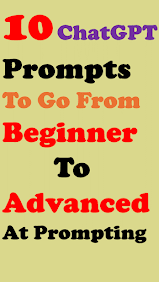Whether you're a
student, creator, entrepreneur, or just curious about AI, learning how to
effectively interact with ChatGPT is a game-changer. Prompting is more than
just asking questions—it's the key to unlocking ChatGPT’s full potential.
In this blog post,
you'll learn 10 powerful prompts that will help you go from a beginner
to an advanced user of ChatGPT. We’ll start simple and gradually build up your
prompting skills, ensuring that by the end, you’ll be able to craft effective
prompts that result in insightful, structured, and creative responses.
Let’s dive in!
🟢 Beginner Prompts: Understanding the Basics
At the beginner level,
the focus is on learning how to phrase questions properly to get clear
and useful responses. These prompts help you break down concepts, get quick
tips, and avoid common mistakes.
1. “Explain [topic]
like I’m 10 years old.”
Example:
Explain blockchain
like I’m 10 years old.
Why it works:
This prompt helps simplify
complex ideas into easy-to-understand explanations. By asking ChatGPT to
adjust its response to the level of a child, you encourage the model to remove
jargon and unnecessary complexity, making it perfect for learning new topics or
refreshing your understanding.
Bonus Tip:
If you need a slightly
more detailed version, try adjusting the phrasing to:
- “Explain [topic] as if I’m in high
school.”
- “Break this down for a total beginner.”
- “Describe [concept] using a simple
analogy.”
2. “Give me 5 tips
to improve at [skill].”
Example:
Give me 5 tips to
improve at public speaking.
Why it works:
This is a straightforward
prompt that delivers actionable advice on almost anything—writing, fitness,
productivity, business, or even creative skills. By specifying the number of
tips, you ensure the response is neatly structured and doesn’t overwhelm you
with excessive details.
Bonus Tip:
Try modifying it for
deeper insights:
- “Give me the top 3 mistakes beginners make
in [skill].”
- “What are 10 expert secrets for mastering
[skill]?”
- “Can you provide a step-by-step
improvement plan for [skill]?”
3. “What are some
common mistakes people make when [doing something]?”
Example:
What are some
common mistakes people make when starting a YouTube channel?
Why it works:
Identifying what to
avoid can sometimes be more powerful than learning what to do.
Knowing the common pitfalls ensures you're prepared to sidestep beginner
errors, making the learning process smoother.
Bonus Tip:
Expand the scope with:
- “What are the top mistakes beginners make
in [field] and how can I avoid them?”
- “List five reasons why people fail at
[goal].”
🟡 Intermediate Prompts: Enhancing Your Prompting
Skills
Intermediate prompts
take your ChatGPT interactions to the next level, introducing structured
responses, role-based prompts, and comparative analysis.
4. “Act like a
[role] and help me with [task].”
Example:
Act like a
professional copywriter and help me write a product description for a fitness
app.
Why it works:
This introduces role-based
prompting, which is a major step toward advanced usage. You're shaping how
ChatGPT should think and respond, tailoring its expertise to match the role you
need.
Bonus Tip:
Try variations like:
- “Act like a psychologist and give me
advice on handling stress.”
- “Be an experienced programmer and help me
debug this code.”
- “Pretend you are a CEO—how would you solve
this business problem?”
5. “Summarize this
[text, article, PDF] into key bullet points.”
Example:
Summarize this blog
post into 5 main points: [Paste text]
Why it works:
This prompt is perfect
for digesting long-form content efficiently. Whether you’re summarizing a
report, a research paper, or an article, this ensures you get the key takeaways
quickly.
Bonus Tip:
Modify the depth:
- “Summarize this text into one paragraph.”
- “Extract the key insights from this
article.”
- “Provide a short summary AND your analysis
of it.”
6. “Compare [thing
A] vs [thing B] in terms of [criteria].”
Example:
Compare Notion vs
Evernote in terms of ease of use, features, and price.
Why it works:
Great for decision-making,
this prompt helps you evaluate options quickly with objective breakdowns,
allowing for an easier choice.
Bonus Tip:
Refine it further:
- “Give me a feature-by-feature comparison
of [X] vs [Y].”
- “Which one is better for beginners, and
why?”
🔴 Advanced Prompts: Mastering Prompt Engineering
Advanced prompts are
where ChatGPT truly shines. At this level, you ask for systems, workflows,
personalized guidance, and advanced learning techniques.
7. “Build a system
or workflow for [goal or process].”
Example:
Build a content
creation workflow for a faceless YouTube channel that posts twice a week.
Why it works:
You're now asking
ChatGPT to not just provide facts but to create structured systems
and processes. This is extremely useful for productivity, business, or
project management.
8. “Critique and
improve this content: [Paste your writing, idea, or plan].”
Example:
Critique and
improve this email pitch I wrote: [Paste pitch]
Why it works:
You're now using
ChatGPT as a smart editor or advisor, pushing it to analyze and optimize.
9. “Pretend you're
my mentor in [field]. What should I do in the next 30 days to grow in this
area?”
Example:
Pretend you're my
mentor in freelance writing. What should I do in the next 30 days to get better
and get clients?
10. “Use the
Socratic method to teach me [topic]. Ask me questions to help me understand
better.”
Example:
Use the Socratic
method to teach me the basics of investing.
Final Thoughts
Prompting is a
skill—like any skill, you get better with practice. These prompts represent
a journey—from beginner to advanced, transforming how you interact with AI.
By learning how to
“speak” to ChatGPT effectively, you’ll unlock a whole new level of
productivity and creativity.


Post a Comment